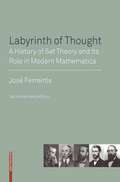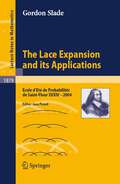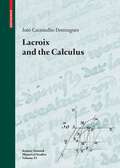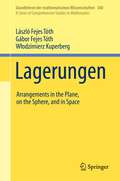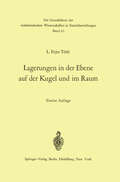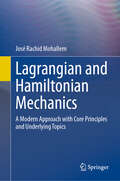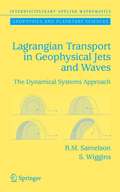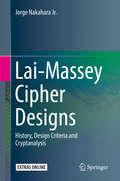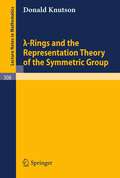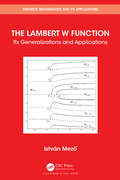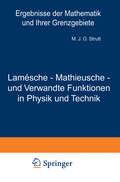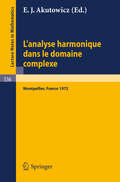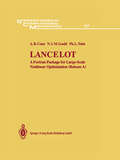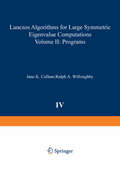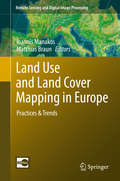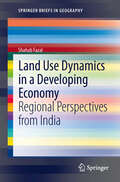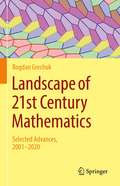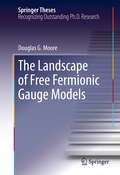- Table View
- List View
Labyrinth of Thought: A History of Set Theory and Its Role in Modern Mathematics
by José Ferreirós"José Ferreirós has written a magisterial account of the history of set theory which is panoramic, balanced, and engaging. Not only does this book synthesize much previous work and provide fresh insights and points of view, but it also features a major innovation, a full-fledged treatment of the emergence of the set-theoretic approach in mathematics from the early nineteenth century." --Bulletin of Symbolic Logic (Review of first edition)
The Lace Expansion and its Applications: Ecole d'Eté de Probabilités de Saint-Flour XXXIV - 2004 (Lecture Notes in Mathematics #1879)
by Gordon SladeThe lace expansion is a powerful and flexible method for understanding the critical scaling of several models of interest in probability, statistical mechanics, and combinatorics, above their upper critical dimensions. These models include the self-avoiding walk, lattice trees and lattice animals, percolation, oriented percolation, and the contact process. This volume provides a unified and extensive overview of the lace expansion and its applications to these models.
Lacroix and the Calculus (Science Networks. Historical Studies #35)
by João Caramalho DominguesSilvestre François Lacroix was not a prominent mathematical researcher, but he was certainly a most influential mathematical book author. His most famous work is the three-volume Traité du calcul différentiel et du calcul intégral, which is an encyclopedic appraisal of 18th-century calculus that remained the standard reference on the subject through much of the 19th century. This book provides the first global and detailed study of Lacroix's Traité Traité du calcul.
Lagerungen: Arrangements in the Plane, on the Sphere, and in Space (Grundlehren der mathematischen Wissenschaften #360)
by László Fejes Tóth Gábor Fejes Tóth Włodzimierz KuperbergThe publication of the first edition of Lagerungen in der Ebene, auf der Kugel und im Raum in 1953 marked the birth of discrete geometry. Since then, the book has had a profound and lasting influence on the development of the field. It included many open problems and conjectures, often accompanied by suggestions for their resolution. A good number of new results were surveyed by László Fejes Tóth in his Notes to the 2nd edition.The present version of Lagerungen makes this classic monograph available in English for the first time, with updated Notes, completed by extensive surveys of the state of the art. More precisely, this book consists of: a corrected English translation of the original Lagerungen,the revised and updated Notes on the original text, eight self-contained chapters surveying additional topics in detail. The English edition provides a comprehensive update to an enduring classic. Combining the lucid exposition of the original text with extensive new material, it will be a valuable resource for researchers in discrete geometry for decades to come.
Lagerungen in der Ebene auf der Kugel und im Raum (Grundlehren der mathematischen Wissenschaften #65)
by L. Fejes TothLagerungen in der Ebene auf der Kugel und im Raum (Grundlehren der mathematischen Wissenschaften #65)
by L. Fejes TothLagrange and Finsler Geometry: Applications to Physics and Biology (Fundamental Theories of Physics #76)
by P. L. Antonelli R. MironLagrange-type Functions in Constrained Non-Convex Optimization (Applied Optimization #85)
by Alexander M. Rubinov Xiao-qi YangLagrange and penalty function methods provide a powerful approach, both as a theoretical tool and a computational vehicle, for the study of constrained optimization problems. However, for a nonconvex constrained optimization problem, the classical Lagrange primal-dual method may fail to find a mini mum as a zero duality gap is not always guaranteed. A large penalty parameter is, in general, required for classical quadratic penalty functions in order that minima of penalty problems are a good approximation to those of the original constrained optimization problems. It is well-known that penaity functions with too large parameters cause an obstacle for numerical implementation. Thus the question arises how to generalize classical Lagrange and penalty functions, in order to obtain an appropriate scheme for reducing constrained optimiza tion problems to unconstrained ones that will be suitable for sufficiently broad classes of optimization problems from both the theoretical and computational viewpoints. Some approaches for such a scheme are studied in this book. One of them is as follows: an unconstrained problem is constructed, where the objective function is a convolution of the objective and constraint functions of the original problem. While a linear convolution leads to a classical Lagrange function, different kinds of nonlinear convolutions lead to interesting generalizations. We shall call functions that appear as a convolution of the objective function and the constraint functions, Lagrange-type functions.
Lagrangian and Hamiltonian Analytical Mechanics: Forty Exercises Resolved and Explained (UNITEXT for Physics)
by Vladimir PletserThis textbook introduces readers to the detailed and methodical resolution of classical and more recent problems in analytical mechanics. This valuable learning tool includes worked examples and 40 exercises with step-by-step solutions, carefully chosen for their importance in classical, celestial and quantum mechanics. The collection comprises six chapters, offering essential exercises on: (1) Lagrange Equations; (2) Hamilton Equations; (3) the First Integral and Variational Principle; (4) Canonical Transformations; (5) Hamilton – Jacobi Equations; and (6) Phase Integral and Angular FrequenciesEach chapter begins with a brief theoretical review before presenting the clearly solved exercises. The last two chapters are of particular interest, because of the importance and flexibility of the Hamilton-Jacobi method in solving many mechanical problems in classical mechanics, as well as quantum and celestial mechanics.Above all, the book provides students and teachers alike with detailed, point-by-point and step-by-step solutions of exercises in Lagrangian and Hamiltonian mechanics, which are central to most problems in classical physics, astronomy, celestial mechanics and quantum physics.
Lagrangian and Hamiltonian Mechanics: A Modern Approach with Core Principles and Underlying Topics
by José Rachid MohallemThis book serves as a textbook for an analytical mechanics course, a fundamental subject of physics, that pays special attention to important topics that are not discussed in most standard textbooks. Readers are provided with a clear understanding of topics that are usually inaccessible to the undergraduate level and that are critical to learning Lagrangian and Hamiltonian mechanics. Each chapter also includes worked problems and solutions, as well as additional exercises for readers to try. This book begins with the fundamentals of analytical mechanics, concisely introducing readers to the calculus of variations, Hamilton’s Principle, and Lagrange’s equations. While presenting readers with these core topics, the author uses an intuitive approach to delve into essential questions, such as where Galilean invariance lies in Lagrangian mechanics and how Hamilton’s Principle of Least Action encompasses Newton’s three laws, interesting conclusions that often go unnoticed. Infact, Hamilton’s principle is taken throughout as the very origin of classical physical laws, and the choice of appropriate Lagrangians in each case as the real theoretical challenge, meaning that forms of Lagrangian which differ from the standard one are not mere curiosities but, instead, the general rule. This book clarifies common misunderstandings that students face when learning the subject and formally rationalizes concepts that are often difficult to grasp. In addition, the final chapter provides an introduction to a Lagrangian field theory for those interested in learning more advanced topics. Ideal for upper undergraduate and graduate students, this book seeks to teach the intrinsic meaning of the principles and equations taught in an analytical mechanics course and convey their usefulness as powerful theoretical instruments of modern physics.
Lagrangian Optics
by V. Lakshminarayanan Ajoy Ghatak K. ThyagarajanIngeometrical optics, light propagation is analyzed in terms of light rays which define the path of propagation of light energy in the limitofthe optical wavelength tending to zero. Many features oflight propagation can be analyzed in terms ofrays,ofcourse, subtle effects near foci, caustics or turning points would need an analysis based on the wave natureoflight. Allofgeometric optics can be derived from Fermat's principle which is an extremum principle. The counterpart in classical mechanics is of course Hamilton's principle. There is a very close analogy between mechanics ofparticles and optics oflight rays. Much insight (and useful results) can be obtained by analyzing these analogies. Asnoted by H. Goldstein in his book Classical Mechanics (Addison Wesley, Cambridge, MA, 1956), classical mechanics is only a geometrical optics approximation to a wave theory! In this book we begin with Fermat's principle and obtain the Lagrangian and Hamiltonian pictures of ray propagation through various media. Given the current interest and activity in optical fibers and optical communication, analysis of light propagation in inhomogeneous media is dealt with in great detail. The past decade has witnessed great advances in adaptive optics and compensation for optical aberrations. The formalism described herein can be used to calculate aberrations ofoptical systems. Toward the end of the book, we present application of the formalism to current research problems. Of particular interest is the use of dynamic programming techniques which can be used to handle variational/extremum problems. This method has only recently been applied to opticalproblems.
Lagrangian Probability Distributions
by Prem C. Consul Felix FamoyeFills a gap in book literature Examines many new Lagrangian probability distributions and their applications to a variety of different fields Presents background mathematical and statistical formulas for easy reference Detailed bibliography and index Exercises in many chapters May be used as a reference text or in graduate courses and seminars on Distribution Theory and Lagrangian Distributions
Lagrangian Transport in Geophysical Jets and Waves: The Dynamical Systems Approach (Interdisciplinary Applied Mathematics #31)
by Roger M. Samelson Stephen WigginsWritten jointly by a specialist in geophysical fluid dynamics and an applied mathematician, this is the first accessible introduction to a new set of methods for analysing Lagrangian motion in geophysical flows. The book opens by establishing context and fundamental mathematical concepts and definitions, exploring simple cases of steady flow, and touching on important topics from the classical theory of Hamiltonian systems. Subsequent chapters examine the elements and methods of Lagrangian transport analysis in time-dependent flows. The concluding chapter offers a brief survey of rapidly evolving research in geophysical fluid dynamics that makes use of this new approach.
Lai-Massey Cipher Designs
by Jorge Nakahara Jr.This book provides the first extensive survey of block ciphers following the Lai-Massey design paradigm. After the introduction, with historical remarks, the author structures the book into a chapter on the description of the PES, IDEA and other related ciphers, followed by a chapter on cryptanalysis of these ciphers, and another chapter on new cipher designs. The appendices include surveys of cryptographic substitution boxes and of MDS codes. This comprehensive treatment can serve as a reference source for researchers, students and practitioners.
Lambda-Rings and the Representation Theory of the Symmetric Group (Lecture Notes in Mathematics #308)
by Donald KnutsonThe Lambert W Function: Its Generalizations and Applications (Discrete Mathematics and Its Applications)
by Istvan MezoThis book is the very first one in the English language entirely dedicated to the Lambert W function, its generalizations, and its applications. One goal is to promote future research on the topic. The book contains all the information one needs when trying to find a result. The most important formulas and results are framed. The Lambert W function is a multi-valued inverse function with plenty of applications in areas like molecular physics, relativity theory, fuel consumption models, plasma physics, analysis of epidemics, bacterial growth models, delay differential equations, fluid mechanics, game theory, statistics, study of magnetic materials, and so on. The first part of the book gives a full treatise of the W function from theoretical point of view. The second part presents generalizations of this function which have been introduced by the need of applications where the classical W function is insufficient. The third part presents a large number of applications from physics, biology, game theory, bacterial cell growth models, and so on. The second part presents the generalized Lambert functions based on the tools we had developed in the first part. In the third part familiarity with Newtonian physics will be useful. The text is written to be accessible for everyone with only basic knowledge on calculus and complex numbers. Additional features include the Further Notes sections offering interesting research problems and information for further studies. Mathematica codes are included. The Lambert function is arguably the simplest non-elementary transcendental function out of the standard set of sin, cos, log, etc., therefore students who would like to deepen their understanding of real and complex analysis can see a new “almost elementary” function on which they can practice their knowledge.
The Lambert W Function: Its Generalizations and Applications (Discrete Mathematics and Its Applications)
by Istvan MezoThis book is the very first one in the English language entirely dedicated to the Lambert W function, its generalizations, and its applications. One goal is to promote future research on the topic. The book contains all the information one needs when trying to find a result. The most important formulas and results are framed. The Lambert W function is a multi-valued inverse function with plenty of applications in areas like molecular physics, relativity theory, fuel consumption models, plasma physics, analysis of epidemics, bacterial growth models, delay differential equations, fluid mechanics, game theory, statistics, study of magnetic materials, and so on. The first part of the book gives a full treatise of the W function from theoretical point of view. The second part presents generalizations of this function which have been introduced by the need of applications where the classical W function is insufficient. The third part presents a large number of applications from physics, biology, game theory, bacterial cell growth models, and so on. The second part presents the generalized Lambert functions based on the tools we had developed in the first part. In the third part familiarity with Newtonian physics will be useful. The text is written to be accessible for everyone with only basic knowledge on calculus and complex numbers. Additional features include the Further Notes sections offering interesting research problems and information for further studies. Mathematica codes are included. The Lambert function is arguably the simplest non-elementary transcendental function out of the standard set of sin, cos, log, etc., therefore students who would like to deepen their understanding of real and complex analysis can see a new “almost elementary” function on which they can practice their knowledge.
Lamésche - Mathieusche - und Verwandte Funktionen in Physik und Technik: Band 3 (Ergebnisse der Mathematik und Ihrer Grenzgebiete. 1. Folge #3)
by Maximilian J. StruttDieser Buchtitel ist Teil des Digitalisierungsprojekts Springer Book Archives mit Publikationen, die seit den Anfängen des Verlags von 1842 erschienen sind. Der Verlag stellt mit diesem Archiv Quellen für die historische wie auch die disziplingeschichtliche Forschung zur Verfügung, die jeweils im historischen Kontext betrachtet werden müssen. Dieser Titel erschien in der Zeit vor 1945 und wird daher in seiner zeittypischen politisch-ideologischen Ausrichtung vom Verlag nicht beworben.
L'Analyse Harmonique dans le Domaine Complexe: Actes de la Table Ronde Internationale du Centre National de la Recherche Scientifique tenue a Montpellier du 11 au 15 septembre 1972 (Lecture Notes in Mathematics #336)
by E. J. AkutowiczLancelot: A Fortran Package for Large-Scale Nonlinear Optimization (Release A) (Springer Series in Computational Mathematics #17)
by A.R. Conn G.I.M. Gould P.L. TointLANCELOT is a software package for solving large-scale nonlinear optimization problems. This book is our attempt to provide a coherent overview of the package and its use. This includes details of how one might present examples to the package, how the algorithm tries to solve these examples and various technical issues which may be useful to implementors of the software. We hope this book will be of use to both researchers and practitioners in nonlinear programming. Although the book is primarily concerned with a specific optimization package, the issues discussed have much wider implications for the design and im plementation of large-scale optimization algorithms. In particular, the book contains a proposal for a standard input format for large-scale optimization problems. This proposal is at the heart of the interface between a user's problem and the LANCE LOT optimization package. Furthermore, a large collection of over five hundred test ex amples has already been written in this format and will shortly be available to those who wish to use them. We would like to thank the many people and organizations who supported us in our enterprise. We first acknowledge the support provided by our employers, namely the the Facultes Universitaires Notre-Dame de la Paix (Namur, Belgium), Harwell Laboratory (UK), IBM Corporation (USA), Rutherford Appleton Laboratory (UK) and the University of Waterloo (Canada). We are grateful for the support we obtained from NSERC (Canada), NATO and AMOCO (UK).
Lanczos Algorithms for Large Symmetric Eigenvalue Computations Vol. II Programs (Progress in Scientific Computing #4)
by Cullum WilloughbyLand Use and Land Cover Mapping in Europe: Practices & Trends (Remote Sensing and Digital Image Processing #18)
by Ioannis Manakos Matthias BraunLand use and land cover (LULC) as well as its changes (LUCC) are an interplay between bio-geophysical characteristics of the landscape and climate as well as the complex human interaction including its different patterns of utilization superimposed on the natural vegetation. LULC is a core information layer for a variety of scientific and administrative tasks(e.g. hydrological modelling, climate models, land use planning).In particular in the context of climate change with its impacts on socio-economic, socio-ecologic systems as well as ecosystem services precise information on LULC and LUCC are mandatory baseline datasets required over large areas. Remote sensing can provide such information on different levels of detail and in a homogeneous and reliable way. Hence, LULC mapping can be regarded as a prototype for integrated approaches based on spaceborne and airborne remote sensing techniques combined with field observations. The book provides for the first time a comprehensive view of various LULC activities focusing on European initiatives, such as the LUCAS surveys, the CORINE land covers, the ESA/EU GMES program and its resulting Fast-Track- and Downstream Services, the EU JRC Global Land Cover, the ESA GlobCover project as well as the ESA initiative on Essential Climate Variables. All have and are producing highly appreciated land cover products. The book will cover the operational approaches, but also review current state-of-the-art scientific methodologies and recommendations for this field. It opens the view with best-practice examples that lead to a view that exceeds pure mapping, but to investigate into drivers and causes as well as future projections.
Land Use Dynamics in a Developing Economy: Regional Perspectives from India (SpringerBriefs in Geography)
by Shahab FazalToday, India still remains a rural agricultural country although the share of urban population has also increased but these figures do not tell the whole story. There are evidences that urban growth is dispersed and urban sprawl promotes the spread of urban land use into the rural-urban fringe. Here the attempt is to investigate the land transformation and the driving forces which were influencing the land transformation. The present study was done on peri urban interface of Aligarh city, a relatively small city, but as other north Indian cities, it is also expanding rapidly. Moreover, it too is surrounded by a populous rural area with productive and rich agricultural hinterland. Such conditions give rise to many conflicts and mutually beneficial complementarities in the rural and urban spheres. The result shows that the demand for land is high which results in informal urban development fulfilling the requirements of many of the city’s residents. Every piece of land is a tradable commodity, and the pursuit of short-term profits is the predominant ethic. The actors in PUI are strong because it is characterized by intermixing of rural and urban activities and interests as well as the number of actors are greater than in any other area..
Landscape of 21st Century Mathematics: Selected Advances, 2001–2020
by Bogdan GrechukLandscape of 21st Century Mathematics offers a detailed cross section of contemporary mathematics. Important results of the 21st century are motivated and formulated, providing an overview of recent progress in the discipline.The theorems presented in this book have been selected among recent achievements whose statements can be fully appreciated without extensive background. Grouped by subject, the selected theorems represent all major areas of mathematics: number theory, combinatorics, analysis, algebra, geometry and topology, probability and statistics, algorithms and complexity, and logic and set theory. The presentation is self-contained with context, background and necessary definitions provided for each theorem, all without sacrificing mathematical rigour. Where feasible, brief indications of the main ideas of a proof are given.Rigorous yet accessible, this book presents an array of breathtaking recent advances in mathematics. It is written for everyone with a background in mathematics, from inquisitive university students to mathematicians curious about recent achievements in areas beyond their own.
The Landscape of Free Fermionic Gauge Models (Springer Theses)
by Douglas G. MooreIn this thesis, the author describes the development of a software framework to systematically construct a particular class of weakly coupled free fermionic heterotic string models, dubbed gauge models. In their purest form, these models are maximally supersymmetric (N = 4), and thus only contain superpartners in their matter sector. This feature makes their systematic construction particularly efficient, and they are thus useful in their simplicity. The thesis first provides a brisk introduction to heterotic strings and the spin-structure construction of free fermionic models. Three systematic surveys are then presented, and it is conjectured that these surveys are exhaustive modulo redundancies. Finally, the author presents a collection of metaheuristic algorithms for searching the landscape for models with a user-specified spectrum of phenomenological properties, e.g. gauge group and number of spacetime supersymmetries. Such algorithms provide the groundwork for extended generic free fermionic surveys.
